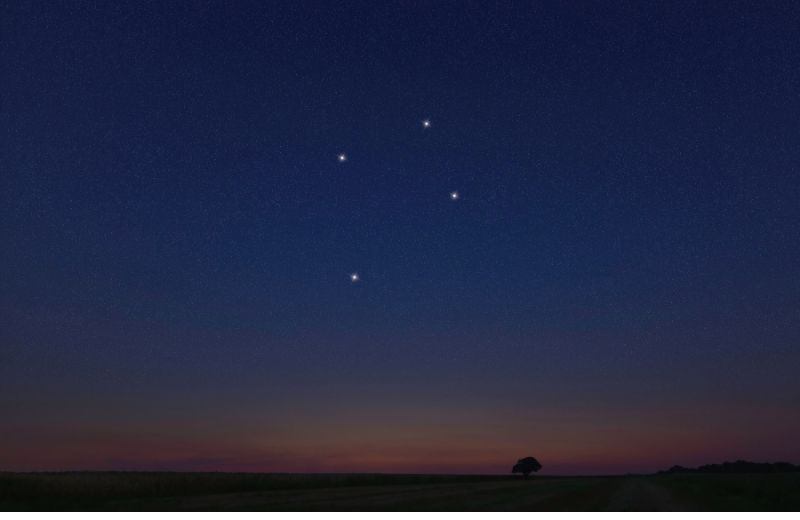The Crux constellation, also known as the Southern Cross, is a prominent feature of the southern hemisphere's night sky. With its distinctive cross-like shape and rich cultural significance, Crux is an astronomer’s favourite. In this guide, you'll discover the fascinating story of Crux, its stars, and how you can find it in the night sky.
Jump to:
Recommended for you!
Best SellersWhat is the Crux Constellation?
The Crux constellation, often referred to as the Southern Cross, is a small but prominent constellation in the southern hemisphere. It consists of five primary stars that form a cross-shaped pattern. Despite its relatively small size, Crux is one of the most recognisable constellations and holds great importance in navigation, culture, and mythology.
Located near the Milky Way, Crux stands out in the southern sky due to its brightness and distinctive shape. While the constellation is most visible from the southern hemisphere, its fame has spread across the globe, and it even features on several national flags, including Australia and New Zealand.
What Does Crux Look Like?

Crux is made up of five stars, with four forming the shape of a cross and one being slightly off-centre. The two brightest stars are Alpha Crucis and Beta Crucis, both of which are easy to spot due to their brilliance. The other stars, Gamma Crucis, Delta Crucis, and Epsilon Crucis, complete the cross formation.
The constellation is located near the constellation Centaurus and is bordered by the Musca constellation. Its small size makes it easy to recognise, even with the naked eye, but you'll need to be in the southern hemisphere to get the best view of this southern star constellation.
The Crux Constellation Myth
The mythology behind Crux is captivating. In ancient Greek mythology, Crux was once part of the Centaurus constellation. However, as the centuries passed, Crux gradually became more associated with the Southern Hemisphere, disappearing from the view of Northern Hemisphere observers.
In some cultures, the Southern Cross is seen as a symbol of guidance and protection. For example, in Polynesian navigation, the Southern Cross was essential in helping travellers find their way across the vast Pacific Ocean. The mythological significance of Crux varies across different societies, but it has often been associated with themes of direction, strength, and spiritual guidance.
What is the Meaning of the Crux Constellation?

Crux, meaning "cross" in Latin, has a deep symbolic significance. Its cross-like shape is often linked to religious and spiritual interpretations. In astrology, the Crux constellation is thought to symbolise faith and guidance. The spiritual meaning of the constellation Crux is often seen as a reminder of endurance, protection, and the connection between the heavens and Earth.
In many southern hemisphere cultures, the Southern Cross represents hope and navigation. It has been a key reference point for sailors and explorers for centuries, helping them to navigate the seas. The constellation's meaning transcends practical navigation, though; it holds spiritual importance, symbolising guidance through life's challenges.
Crux's Stars

The Crux constellation's main stars each have their unique characteristics:
- Alpha Crucis: Also known as Acrux, it is the brightest star in Crux and one of the brightest stars in the night sky. It is a multiple star system with two main stars that are both blue-white giants.
- Beta Crucis: Also called Mimosa, this star is the second brightest in Crux. It is a massive blue giant and a variable star, meaning its brightness changes over time.
- Gamma Crucis: Unlike the first two stars, Gamma Crucis is a red giant. It marks the top of the cross and is relatively close to Earth.
- Delta Crucis: This star, located at the left side of the cross, is a blue-white giant star.
- Epsilon Crucis: Although fainter than the others, Epsilon Crucis still plays an essential role in forming the shape of the cross. It is an orange giant star.
Together, these stars create the iconic Southern Cross, which has guided countless travellers and fascinated astronomers for generations.
Nebulae in the Crux Constellation
Crux is also home to fascinating deep-sky objects, including nebulae. The most famous nebula in the Crux constellation is the Coalsack Nebula. This dark nebula is a cloud of interstellar dust that blocks light from the stars behind it, creating a striking silhouette against the Milky Way.
The Coalsack Nebula is visible to the naked eye and is best observed in the southern hemisphere, where it appears as a dark patch near the bright stars of Crux.
Recommended for you!
Best SellersFinding Crux in the Sky
Crux is best observed from the southern hemisphere, making it a popular target for stargazers in regions like Australia, New Zealand, and parts of South America. Known for its cross-like formation, Crux is visible throughout the year from southern latitudes and is a familiar sight in the night sky.
Locating Crux
To locate Crux, begin by finding the constellation Centaurus. Within this constellation, you'll spot two bright stars, Alpha and Beta Centauri, often referred to as the "Pointer Stars." These stars act as a guide, pointing directly towards Crux. Once you've identified these pointer stars, Crux's cross shape will become evident nearby.
Viewing Crux with Binoculars or a Telescope
- With Binoculars: The main stars of Crux are easy to spot with the naked eye, but binoculars will provide a clearer view of the fainter stars that complete the cross shape.
- With a Telescope: A telescope will allow you to explore not just the stars of Crux, but also the surrounding nebulae, such as the Coalsack Nebula, enhancing your stargazing experience.
The Best Viewing Times
The best time to view Crux is during the evening hours, especially during the southern hemisphere's autumn and winter months. For the clearest view, seek out a location with minimal light pollution and allow your eyes to adjust to the darkness. Under optimal conditions, the Southern Cross will be a prominent feature of the night sky.
While Crux is primarily a southern hemisphere constellation, it can be spotted from tropical regions in the northern hemisphere, though only for brief periods and at certain times of the year.
Fun Facts About Crux
- Crux is the smallest constellation: Despite its fame, Crux is the smallest of all 88 recognised constellations, covering just 68 square degrees of the sky.
- It appears on national flags: The Southern Cross features on the flags of Australia, New Zealand, Papua New Guinea, and Brazil, symbolising the southern hemisphere.
- Crux was once visible from ancient Greece: Around 4,000 years ago, the Crux constellation could be seen from Greece. However, due to the precession of the Earth's axis, it is no longer visible from northern latitudes.
Study Astronomy for £29
The Crux constellation is a stunning and significant part of the night sky, offering beauty and rich mythology. If you're inspired to delve deeper into the wonders of astronomy, why not explore the Astronomy Diploma Course with Centre of Excellence? Whether you're a beginner or someone with more experience, this course will guide you through everything you need to know about the stars, constellations, and galaxies like Columba. And for a limited time, you can enrol for just £29!













